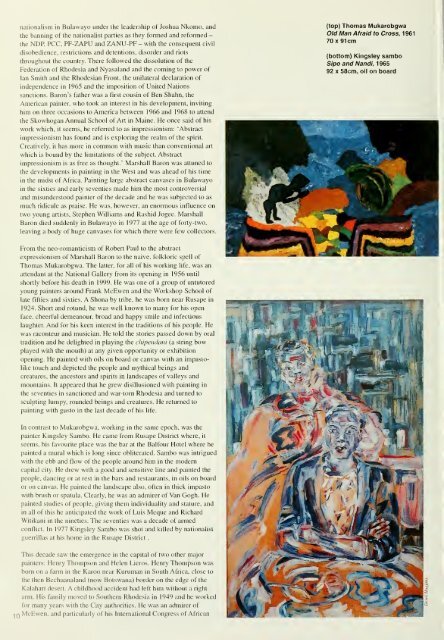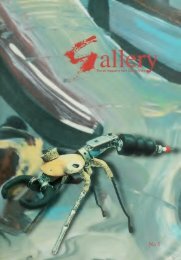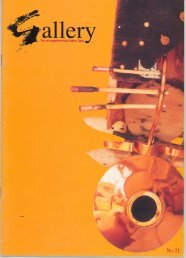Gallery : the art magazine from Gallery Delta
Gallery : the art magazine from Gallery Delta
Gallery : the art magazine from Gallery Delta
- TAGS
- delta
- gallerydelta.com
You also want an ePaper? Increase the reach of your titles
YUMPU automatically turns print PDFs into web optimized ePapers that Google loves.
nationalism in Bulawayo under <strong>the</strong> leadership of Joshua Nkomo, and<br />
<strong>the</strong> banning of <strong>the</strong> nationalist p<strong>art</strong>ies as <strong>the</strong>y formed and reformed -<br />
<strong>the</strong> NDP, PCC, PF-ZAPU and ZANU-PF - with <strong>the</strong> consequent civil<br />
disobedience, restrictions and detentions, disorder and riots<br />
throughout <strong>the</strong> country. There followed <strong>the</strong> dissolution of <strong>the</strong><br />
Federation of Rhodesia and Nyasaland and <strong>the</strong> coming to power of<br />
Ian Smith and <strong>the</strong> Rhodesian Front, <strong>the</strong> unilateral declaration of<br />
independence in 1965 and <strong>the</strong> imposition of United Nations<br />
sanctions. Baron's fa<strong>the</strong>r was a first cousin of Ben Shahn, <strong>the</strong><br />
American painter, who took an interest in his development, inviting<br />
him on three occasions to America between 1966 and 1968 to attend<br />
<strong>the</strong> Skowhogan Annual School of Art in Maine. He once said of his<br />
work which, it seems, he referred to as impressionism: 'Abstract<br />
impressionism has found and is exploring <strong>the</strong> realm of <strong>the</strong> spirit.<br />
Creatively, it has more in common with music than conventional <strong>art</strong><br />
which is bound by <strong>the</strong> limitations of <strong>the</strong> subject. Abstract<br />
impressionism is as free as thought.' Marshall Baron was attuned to<br />
<strong>the</strong> developments in painting in <strong>the</strong> West and was ahead of his time<br />
in <strong>the</strong> midst of Africa. Painting large abstract canvases in Bulawayo<br />
in <strong>the</strong> si,\ties and early seventies made him <strong>the</strong> most controversial<br />
and misunderstood painter of <strong>the</strong> decade and he was subjected to as<br />
much ridicule as praise. He was, however, an enormous influence on<br />
two young <strong>art</strong>ists, Stephen Williams and Rashid Jogee. Marshall<br />
Baron died suddenly in Bulawayo in 1977 at <strong>the</strong> age of forty-two,<br />
leaving a body of huge canvases for which <strong>the</strong>re were few collectors.<br />
From <strong>the</strong> neo-romanticism of Robert Paul to <strong>the</strong> abstract<br />
expressionism of Marshall Baron to <strong>the</strong> naive, folkloric spell of<br />
Thomas Mukarobgwa. The latter, for all of his working life, was an<br />
attendant at <strong>the</strong> National <strong>Gallery</strong> <strong>from</strong> its opening in 1956 until<br />
shortly before his death in 1999. He was one of a group of untutored<br />
young painters around Frank McEwen and <strong>the</strong> Workshop School of<br />
late fifties and sixties. A Shona by tribe, he was bom near Rusape in<br />
1924. Short and rotund, he was well known to many for his open<br />
face, cheerful demeanour, broad and happy smile and infectious<br />
laughter. And for his keen interest in <strong>the</strong> traditions of his people. He<br />
was raconteur and musician. He told <strong>the</strong> stories passed down by oral<br />
tradition and he delighted in playing <strong>the</strong> chipendani (a string bow<br />
played with <strong>the</strong> mouth) at any given opportunity or exhibition<br />
opening. He painted with oils on board or canvas with an impasto-<br />
like touch and depicted <strong>the</strong> people and mythical beings and<br />
creatures, <strong>the</strong> ancestors and spirits in landscapes of valleys and<br />
mountains. It appeared that he grew disillusioned with painting in<br />
<strong>the</strong> seventies in sanctioned and war-torn Rhodesia and turned to<br />
sculpting lumpy, rounded beings and creatures. He returned to<br />
painting with gusto in <strong>the</strong> last decade of his life.<br />
In contrast to Mukarobgwa, working in <strong>the</strong> same epoch, was <strong>the</strong><br />
painter Kingsley Sambo. He came <strong>from</strong> Rusape District where, it<br />
seems, his favourite place was <strong>the</strong> bar at <strong>the</strong> Balfour Hotel where he<br />
painted a mural which is long since obliterated. Sambo was intrigued<br />
with <strong>the</strong> ebb and flow of <strong>the</strong> people around him in <strong>the</strong> modem<br />
capital city. He drew with a good and .sensitive line and painted <strong>the</strong><br />
people, dancing or at rest in <strong>the</strong> bars and restaurants, in oils on board<br />
or on canvas. He painted <strong>the</strong> landscape also, often in thick impa.sto<br />
with brush or spatula. Clearly, he was an admirer of Van Gogh. He<br />
painted studies of people, giving <strong>the</strong>m individuality and stature, and<br />
in all of this he anticipated <strong>the</strong> work of Luis Meque and Richard<br />
Witikani in <strong>the</strong> nineties. The seventies was a decade of armed<br />
conflict. In 1977 Kingsley Sambo was shot and killed by nationalist<br />
guerrillas at his home in <strong>the</strong> Rusape District .<br />
This decade saw <strong>the</strong> emergence in <strong>the</strong> capital of two o<strong>the</strong>r major<br />
painters; Henry Thompson and Helen Lieros. Henry Thompson was<br />
bom on a farm in <strong>the</strong> Karoo near Kumman in South Africa, close to<br />
<strong>the</strong> <strong>the</strong>n Bechuanaland (now Botswana) border on <strong>the</strong> edge of <strong>the</strong><br />
Kalahari desert. A childhood accident had left him without a right<br />
arm. His family moved to Sou<strong>the</strong>m Rhodesia in 1949 and he worked<br />
for many years with <strong>the</strong> City authorities. He was an admirer of<br />
^Q McEwen, and p<strong>art</strong>icularly of his International Congress of African<br />
(top) Thomas Mukarobgwa<br />
Old Man Afraid to Cross, 1961<br />
70 X 91cm<br />
(bottom) Kingsley sambo<br />
Sipo and Nandi, 1965<br />
92 X 58cm, oil on board







